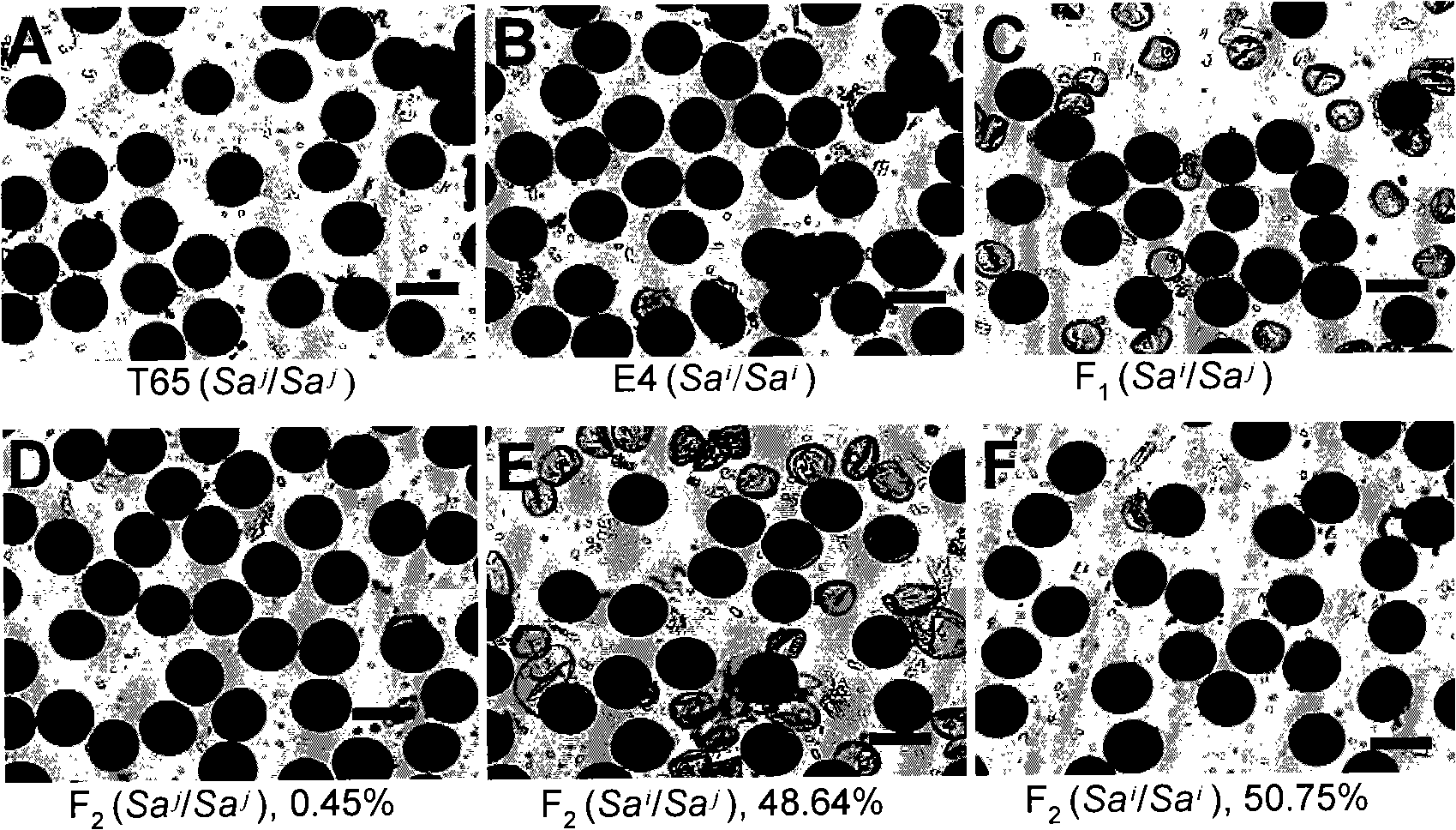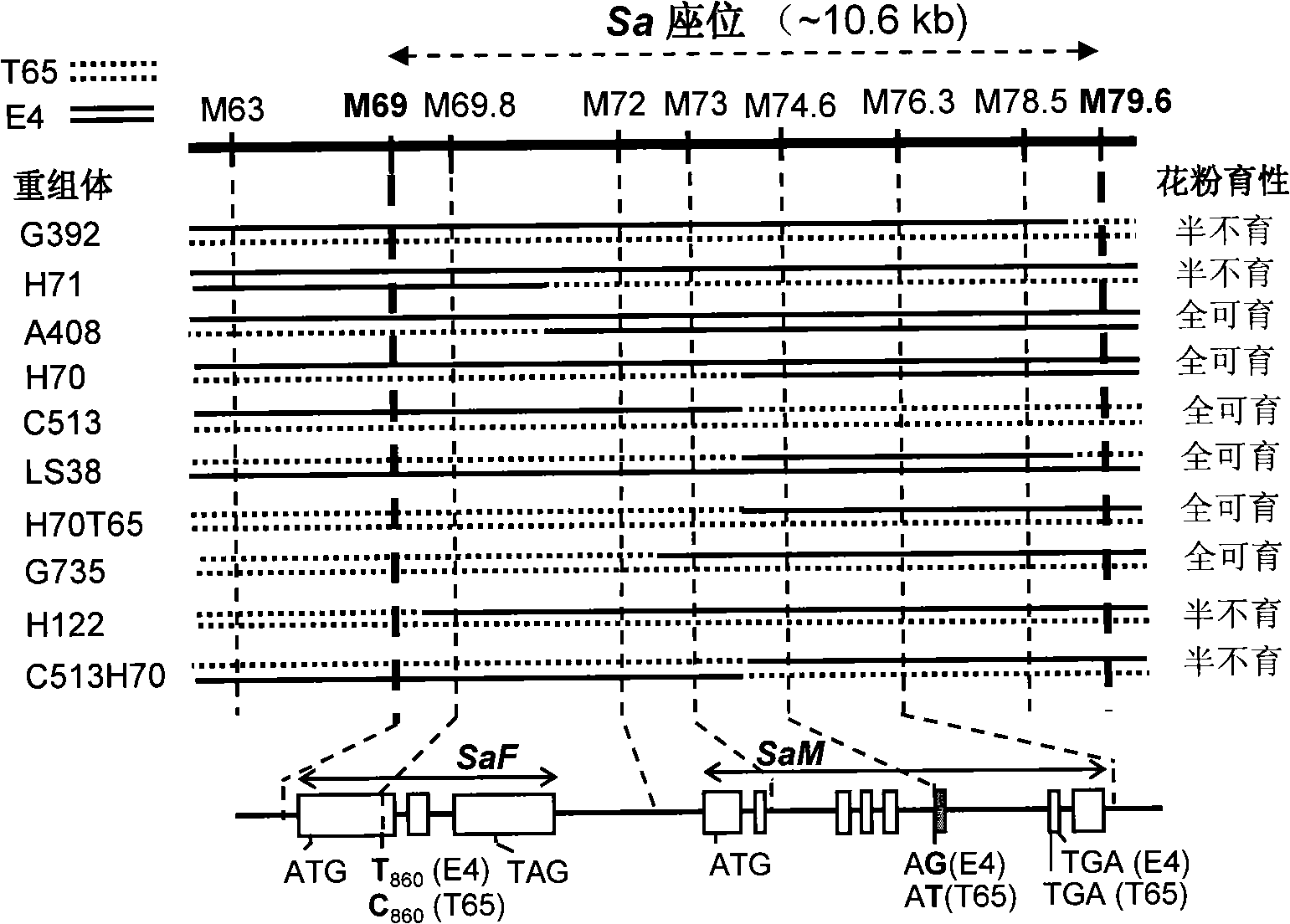Rice hybrid pollen fertility gene and uses thereof
A fertility gene and hybrid technology, applied in the field of genetic engineering, can solve the problems of hybrid pollen sterility or unclear molecular basis of affinity
- Summary
- Abstract
- Description
- Claims
- Application Information
AI Technical Summary
Problems solved by technology
Method used
Image
Examples
Embodiment 1
[0034] Example 1: Screening of polymorphic molecular markers and fine mapping of Sa
[0035] It is known that Sa is located in the approximate region on the first chromosome of rice (Zhuang Chuxiong et al. 1994, Acta Genetica Sinica 21: 34-37). The present invention uses as figure 2 The shown map-based cloning method further cloned the Sa gene. First, the japonica rice variety Taichung 65 (abbreviated as T65, with genotype Sa j Sa j ) and its near isogenic line E4 (Sa i Sa i ) crossed to create a F 2 generational segregation groups. The near-isogenic line E4 used in the present invention is except Sa i The allelic locus and its surrounding regions are derived from a line other than indica rice whose nuclear genome background is the same as T65 (Zhuang Chuxiong et al. 1994, Acta Genetica Sinica 21: 34-37). Therefore the genetic segregation of male sterility in their hybrids is limited only by Sa i Sa j Effects of heterozygous gene interaction effects. with 1%I 2 -K...
Embodiment 2
[0041] Example 2: Sequence analysis of genes related to the Sa locus
[0042] According to the genome DNA sequence of rice (japonica) published by GenBank and the RiceGAAS software (http: / / ricegaas.dna.affrc.go.jp) analysis, there are only 2 predicted genes in the positioning region, named SaM respectively and SaF. Genetic analysis showed that in different F 2 Among recombinants, only individuals containing heterozygous SaM and one or two SaF alleles derived from E4, that is, heterozygous SaF or homozygous E4SaF, can produce hybrid pollen semi-sterile ( figure 2 ). It was shown that the Sa locus was composed of SaF and SaM, and the genetic interaction of the three alleles of these two genes produced hybrid sterility.
[0043] Use primer 5'TCTAAG GGATCC AGGCGCGGGTGAAGCAAACTAGAC-3' (underlined as BamHI) and 5'ATTTAA GAATTC GCCGTCTTAACACACATTGGAAAA-3' (underlined as EcoRI) from T65, E4, and multiple indica types (Guangluai 4, 93-11, Minghui 63, etc.) and japonica types (N...
Embodiment 3
[0045] Example 3: Genetic transformation to identify the function of the target gene
[0046] With the SaM described in embodiment 2 + 、SaM - , and SaF + , which include the promoter region, coding region, and downstream sequences, were cloned into the binary transformation vector pCAMBIA1300 (CAMBIA, Australia). The obtained vector transgenes were named tSaM + , tSaM - , and tSaF + . These vectors were introduced into soil Agrobacterium tumefaciens strain EHA105 by electric shock method, and rice with suitable genotype was transformed by Agrobacterium tumefaciens-mediated method (Hiei et al., Plant J.6: 271-282). tSaM - Transform containing genotype to SaM + / SaM + / / SaF + / SaF + E4, obtained from 4 strains of T 0 Transformants showed semi-sterile pollen ( Figure 4 A). tSaM + Transformation of the genotype SaM isolated from the hybrid progeny produced by crossing 65 with E4 - / SaM - / / SaF + / SaF - The pollen fully fertile recombinants obtained 8 T 0 The f...
PUM
 Login to View More
Login to View More Abstract
Description
Claims
Application Information
 Login to View More
Login to View More - R&D
- Intellectual Property
- Life Sciences
- Materials
- Tech Scout
- Unparalleled Data Quality
- Higher Quality Content
- 60% Fewer Hallucinations
Browse by: Latest US Patents, China's latest patents, Technical Efficacy Thesaurus, Application Domain, Technology Topic, Popular Technical Reports.
© 2025 PatSnap. All rights reserved.Legal|Privacy policy|Modern Slavery Act Transparency Statement|Sitemap|About US| Contact US: help@patsnap.com



